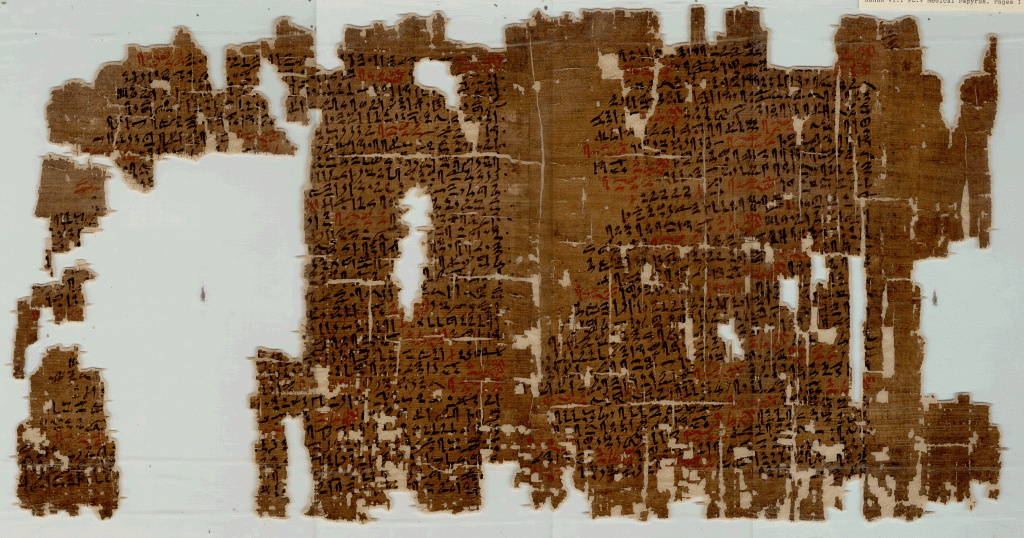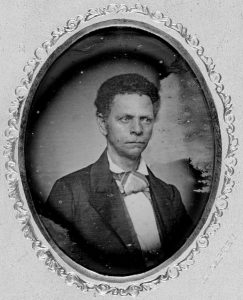Winner of the Fall 2017 StMU History Media Award for
Best Article in the Category of “Gender Studies”
Best Overall Research
For most of modern memory, the predominant belief was that sex was for procreation, and that pleasure was a sin.1 As a result, members of modern society tend to assume that contraception is a fairly recent practice. Yet, contrary to popular belief, many ancient societies believed in sex for pleasure. For instance, some of the earliest medical writings show contraception played a role in Egyptian society.2 Some question the efficacy of the contraceptive techniques as another method of suggesting that sex for pleasure was not historically possible. But there is little doubt that the reason for the Egyptians’ seeking effective contraception was to permit sex without the concern of procreation, hence sex solely for pleasure. Indeed, sources like the Kahun Papyrus show us that our ancient and pre-modern ancestors knew a good deal about reproduction and effective contraception—proving that Egyptian women had more control over their sexuality in ancient times than many woman have enjoyed since the rise of modern religions.3
The main source of historical evidence that contributes to this debate between contraception and infant mortality, and between magic and medicine, is the Kahun Gynecological Papyrus.4 The Kahun Papyrus was discovered by Petrie Flinders in 1889 in a small village called El-Lahun, one-hundred kilometers south-west of Cairo. It dates to 1850 B.C.E., and is the earliest record of ancient Egyptian medical practices. The papyrus is entirely gynecological in nature and is written in hieratic script, not hieroglyphs. It did not become legible until 1806 after the discovery of the Rosetta stone.5 It is divided into thirty-four sections, each dealing with a specific problem relating to gynecological disease, fertility, contraception, and pregnancy. Three of these fragments are prescriptions that relate specifically to preventing conception, all of which involve vaginal suppositories.6 When Flinders found the papyrus, it was badly damaged with small fragments of text missing.7 These missing fragments keep the debate alive as to how exactly some of these remedies were used.
However, despite the long-held belief among scholars that the relative stability of ancient populations was linked to a high infant mortality rate, there is significant evidence that shows that that was not the case.8 The Kahun Papyrus shows us that Egyptian medical practices were based in fact and knowledge, with only a sprinkling of the supernatural. In his book, Contraception and Abortion from the Ancient World to Renaissance, John Riddle, a leading expert of ancient pharmacology, makes the argument that population stability was not linked to high infant mortality rates. Instead, Riddle asserts that population control was due to the use of herbal contraceptives by women.9 The ancient world held much more knowledge of contraceptives than previously thought.10

The main treatments detailed in the papyrus were founded in Egyptians’ knowledge and observations of herbs, plants, minerals, and the effects these items in nature had on animals. The Egyptians noticed that when animals ate certain plants they failed to reproduce. They carried this observation over into their reproductive techniques. Ingredients listed in the contraceptive techniques include acacia gum, sour milk, crocodile dung, fiber, and honey.11 These ingredients were mixed into a pessary and inserted into the vagina by a swnw, or person who was skilled in the art of healing. The pessary would work to block the sperm from reaching a woman’s fallopian tubes and finding an egg to fertilize. When the method using sour milk was tested, the results showed that the enhancement of the acidic environment of the vagina with the introduction of sour milk establishes an effective spermicide, thus proving that the Egyptians did use medicinal techniques that were based on fact, not simply on fiction.12
The existence of contraceptive treatments reflected within the Kahun Papyrus combined with their demonstrated effectiveness leads to the extrapolation that population control was both a desired and achievable outcome for ancient Egyptians. If John Riddle’s theory that the Egyptians actively prevented pregnancy is correct—and the evidence suggests that it is—then we can conclude that sex was not only for reproduction, but for enjoyment.13 In her book Sexual Deviance and Society, Meredith G. F Worthen asserts that sexual imagery from more than 5,000 years ago has been credited to ancient Egyptian cultures. Although we may see these depictions as pornography, to ancient Egyptians they were just a part of sexual life.14 This could lead to the belief that ancient Egyptians were not exactly modest when it came to sexuality and sexual pleasure. To freely express their sexuality, effective contraceptives were a necessity.

Overall, the evidence directs us to the fact that Egyptians held knowledge about contraceptives and used them to prevent pregnancy. So why is the modern belief that contraceptives are a new invention, rather than several millennia old? The answer lies in the rise of Christianity. Before Christianity found its foothold as a highly influential religion, early humans often equated sexual and religious experiences. Christian hostility to sexuality built steadily in the early centuries of the religion. This hostility produced a new attitude of denunciation of women’s sexuality. Early Christians promoted the narrative that Jesus was not born from normal sexual activity, but from a virgin through immaculate conception. Once the religion gained traction, sexual misbehavior was not only seen as a danger to proper human values, but as an offense to God himself. The prevailing belief was that sex was only allowed in marriage and for reproduction. Christian missionaries eventually held enough influence over governments that they pushed them to add new secular penalties to violations of sexual regulations. Secular laws began to target the use of contraception or any other act preventing birth, in some cases the penalty for these acts was death. Over time, Christianity succeeded in chiseling away at “open” sexuality.15 Though modern society has begun to shed this belief, we still see vestiges of it linger in the way sexuality among woman is described. Women who enjoy sex face negative rebukes across the world. These hostile ideologies explain some scholars’ reluctance to accept the fact that ancient Egyptian women enjoyed sex and actively and effectively engaged in it without the outcome of pregnancy.
“Man has always had a desire to heal and control fertility.”16 This truth does not apply only in modern times as many think; the Kahun Papyrus shows that this desire goes all the way back to at least 1825 B.C.E. Yes, the Egyptians’ medical practices were influenced by religion, but we cannot discount their effective techniques simply because they imbibed those practices with the supernatural. Joshua Mark says that “most people would balk at the idea of visiting a doctor and having incantations muttered over them.”17 Yet, we have long had, and still have, very similar rituals in modern Christian society. Doctors will sometimes use their medical knowledge to treat patients, while also praying for or with them. The Kahun Papyrus can be evaluated the same way. We, as a society are reluctant to accept the fact that women are sexual beings, but the historical evidence proves that women have sought control over their sexual experiences since ancient times. That desire is not new to modern society. Steeped in religion though it may be, the papyrus proves our ancient ancestors developed effective techniques for contraception so they would be free to pursue their sexual desires without the fear of procreation.
- Peter N. Stearns, Sexuality in World History (Madison, NY: Routledge, 2009), 47. ↵
- Gary B. Ferngren, “Eve’s Herbs: A History of Contraception and Abortion in the West,” The New England Journal of Medicine 341, (1997): 1398. ↵
- John Riddle, Contraception and Abortion from the Ancient World to the Renaissance (Cambridge, MA: Harvard University Press, 1992), 67. ↵
- Stephen Quirke, Manuscript for the health of mother and child (London: University of London, 2002), 1-3. ↵
- Chinmoy K. Bose, “The el-Lahun gynecological papyrus,” Hekton International: A Journal of Medical Humanities 9, no.2 (2016), http://hekint.org/the-el-lahun-gynecological-papyrus/. ↵
- John Riddle, Contraception and Abortion from the Ancient World to the Renaissance (Cambridge, MA: Harvard University Press, 1992), 66. ↵
- Chinmoy K. Bose, “The el-Lahun gynecological papyrus,” Hekton International: A Journal of Medical Humanities 9, no.2 (2016), http://hekint.org/the-el-lahun-gynecological-papyrus/. ↵
- Gary B. Ferngren, “Eve’s Herbs: A History of Contraception and Abortion in the West,” The New England Journal of Medicine 341, (1997): 1398. ↵
- Gary B. Ferngren, “Eve’s Herbs: A History of Contraception and Abortion in the West,” The New England Journal of Medicine 341, (1997): 1398. ↵
- Ronit Haimov-Kochman, Arye Hurwitz, Yael Sciaky-Tamir, “Reproduction concepts and practices in ancient Egypt mirrored by modern medicine,” European Journal of Obstetrics and Gynecology and Reproductive Biology 123, no. 1 (2005): 3-8. ↵
- Lesley Smith, “The Kahun Gaynaecological Papyrus: ancient Egyptian medicine,” Journal of Family Planning and Reproductive Health Care 37, no.1 (2010): 54–55. ↵
- Ronit Haimov-Kochman, Arye Hurwitz, Yael Sciaky-Tamir, “Reproduction concepts and practices in ancient Egypt mirrored by modern medicine,” European Journal of Obstetrics and Gynecology and Reproductive Biology 123, no. 1 (2005): 4-5. ↵
- John Riddle, Contraception and Abortion from the Ancient World to the Renaissance (Cambridge, MA: Harvard University Press, 1992), 70. ↵
- Meredith G. F. Worthen, Sexual Deviance and Society: A sociological examination (New York: Routledge, 2016), 140. ↵
- Peter N. Stearns, Sexuality In World History (Madison, NY: Routledge, 2009), 43-48. ↵
- Lesley Smith, “The Kahun Gaynaecological Papyrus: ancient Egyptian medicine,” Journal of Family Planning and Reproductive Health Care 37, no.1 (2010): 54–55. ↵
- Ancient History Encyclopedia, February 2017, s.v “Ancient Egyptian Medical Texts,” Joshua J. Mark. ↵



146 comments
Crystalrose Quintero
It was interesting to read that contraption or sex for pleasure did not rise in recent time periods but came about during ancient time periods. It was so interesting to read that a written record found in the late 1800’s showed to have prescriptions for preventing pregnancy. The article provided such interesting facts about contraception and was full of information that was written in a way that made It flow.
Josemaria Soriano
A really interesting article. Undoubtedly, issues such as abortion are very discussed issues in our times, as were sexual relations as a means of pleasure. To my surprise, I never imagined that the Egyptian Civilization could have debated them. I will begin by commenting on the last thing: in my personal opinion, the mechanism of the human body is so beautiful that it is capable of feeling pleasure when it comes to performing the coital relationship. Hormones and erogenous points give us that climax, proving that sexual relations go far beyond reproduction, something surprisingly conceived by the Egyptians. On the other hand, this article tells us that the Egyptians had a very defined population control policy. In my perspective, this policy is a great cause of their success as a civilization, because it allows a better distribution of food and basic products. I want to clarify that I am not defending abortion, but it is necessary to state the facts: many civilizations perished, in part, because they had no policies of birth control, causing unemployment, poverty and hunger.
Lisa Varela
This article put what I had previously thought to the test and failed. I had never thought of when women began using contraception because I naturally assumed that it was a modern practice. I never thought that the practice went as far back as Ancient Egypt. Ancient Egyptians deserve more credit than what they are given. Working with what they had they did a pretty good job!
Amanda Perez
First and foremost, I’d like to express how creative and interesting this topic is. Many people may see this subject as taboo but it is reality and needs to be brought to light, especially now. Many women are dealing with their own sexual liberation and by looking back to the history women and their sexuality, it may be an easier thing for society to accept.
Troy Leonard
I have to say you did a great job describing how in ancient times were and I really shows how much time have changed as well as the beliefs. I didn’t know that sex for pleasure and not for procreation was so frowned apon. I was extreme shocked when I read that the had their own method for birth control I thought that was very interesting the method they had for it.
Alejandra Mendez
This was a very interesting article on a very interesting topic as well. I never would have thought to question how Egyptians viewed sex, let alone question if they used contraceptives, and to my surprise, they did! It’s amazing to think that such early societies were actually very intelligent and came up with many solutions to their problems. I always assumed that contraceptives were first developed in the 50s when the “pill” was introduced, but I never would have imagined that Egyptians had already thought of this in their time and used a natural remedy they created just from observing animals.
Cherice Leach
This is such a well written article! The facts discussed in it are just as amusing. Growing up as a Christian, I am very familiar with the rules of sex and the ideas that contraception is a recent discovery. It’s interesting to know that ancient Egyptians were practicing contraception long before our modern age figured it out. I would have never of known that this was a method used in ancient times to prevent pregnancy because of the way I was brought up and the fact I was sheltered about this kind of topic.
Cameron Ramirez
The more I read about ancient Egyptian society, the more I think that they lived a pretty decent life. From kohl as eyeliner to the pyramids being made as a volunteer effort the more I read about ancient Egyptian society on the StMU History Media the more I am informed about ancient civilizations. Your article just adds more curious and interesting facts about the Egyptian people which is great. Who would have thought that the Egyptian people had some contraception to prevent pregnancies? Anyways, good work on your article and keep up the good work!
Gabriela Serrato
I must applaud you for such an incredible article. Not only great resources and history, but also your mention of women’s sexuality today that is still under scrutiny is exactly what more need to read about. It is sad that even today sex is almost a taboo subject because so many people believe it to be dirty, and it really does revolve around religion in many cases. It irks me that women are called “slut” and “whore” if they have sexual relations but a man is patted on the back because this behavior is “acceptable for men.” I am grateful for this article because maybe it can help some break their ideas about women and how she chooses to behave sexually, and break some of the double standards. Excellent job.
Tara Sellers
This article is very interesting. I never thought about how the rise of Christianity put the stigma on sex. Also, the fact that there is an ancient birth control in cool too. I wish there was more facts about the medicine and how it was used. Everyone has their own beliefs, but learning about them is always a fascinating lesson.